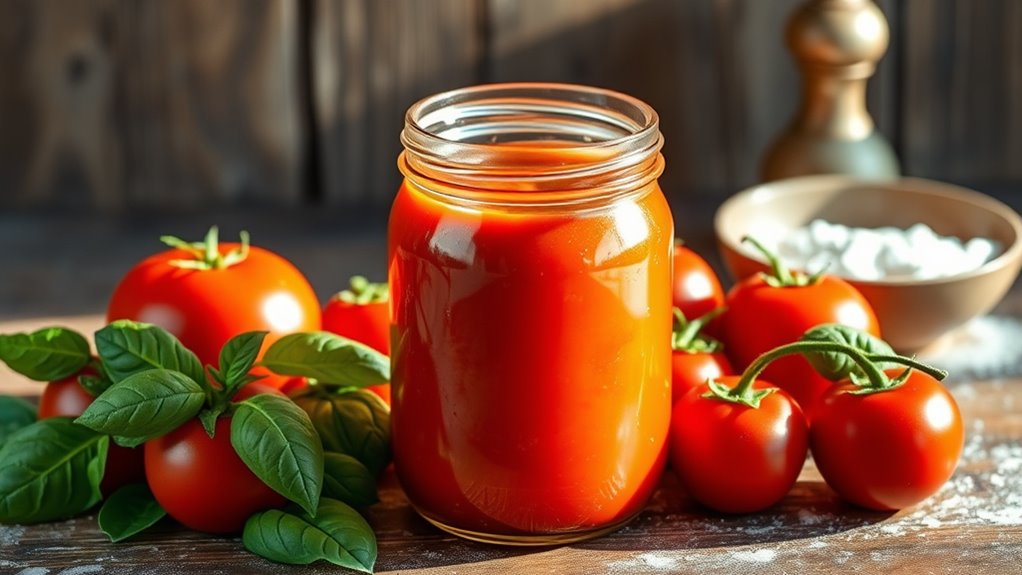Canning tomato basil soup starts with ripe tomatoes, onions, garlic, and fresh basil, all simmered in olive oil and stock until flavorful and smooth. Prep carefully, chop evenly, and keep tools and jars sterilized for safe sealing. Purée to your preferred texture, season well with salt, pepper, and herbs, then ladle into sterilized jars and process in a boiling-water canner. Label with date and batch notes. If you keep going, you’ll reveal more tips and steps.
Ingredients and Quantity
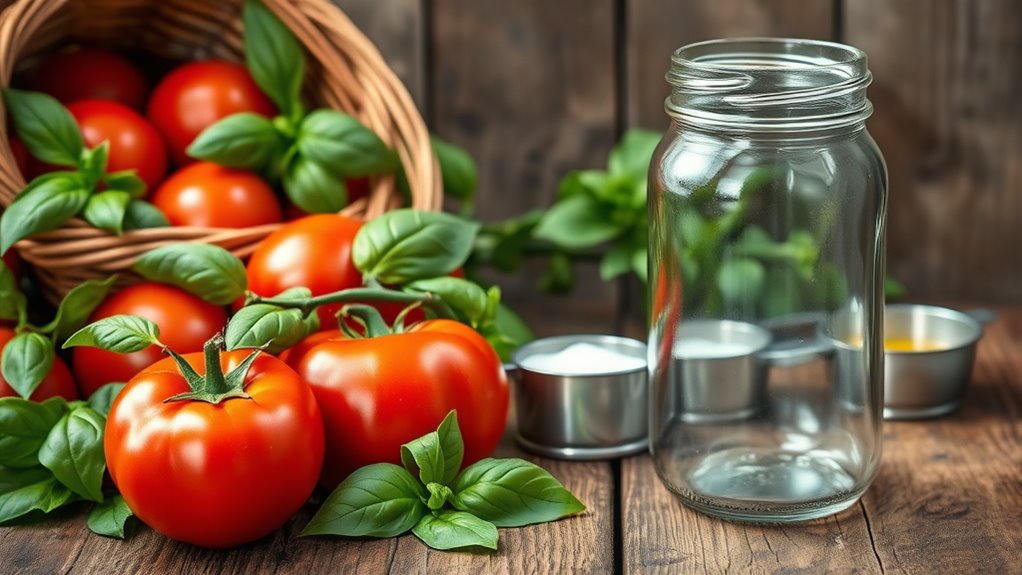
To make Tomato Basil Soup, you’ll need a simple, flavorful set of ingredients: tomatoes (fresh or canned), onion, garlic, vegetable or chicken broth, olive oil, dried oregano or thyme, salt, and pepper, plus fresh basil for finishing.
| Item | Quantity | Notes |
|---|---|---|
| Fresh tomatoes | 2 pounds | Roma or any ripe variety |
| Onion | 1 medium | Chopped |
| Garlic | 3 cloves | Minced |
| Basil leaves | 1/2 cup | Chopped for finish |
You’ll also use olive oil, broth, oregano or thyme, salt, and pepper. Start with fresh tomatoes, then season thoughtfully. The basil leaves add brightness at the end, elevating the soup’s freshness.
Preparations
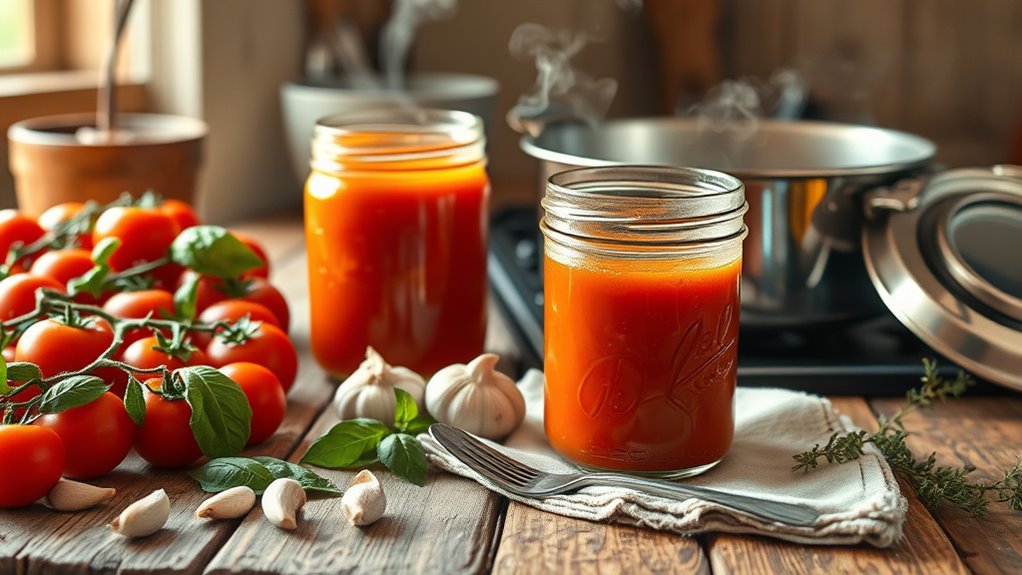
Before you start simmering, prep every ingredient so nothing stalls the process. In this stage, you’ll set the pace with deliberate actions—wash, peel if needed, and chop uniformly for consistent texture. Your focus is on preparation techniques that respect tomatoes, basil, and aromatics, so you don’t waste time during cooking. Gather aromatics, stock, and dairy or dairy-free options, then measure spices precisely. Maintain clean counters and labeled containers to streamline your workflow. Consider ingredient sourcing: choose ripe, flavorful tomatoes and fresh basil from trusted growers, ensuring peak flavor. Pre-portion sauces and bases to facilitate quick adjustments later. Keep an organized mise en place, so you can pivot if your taste profile shifts. This foundation supports confident canning and a vibrant final soup.
Kitchen tools or Kitchenware Required
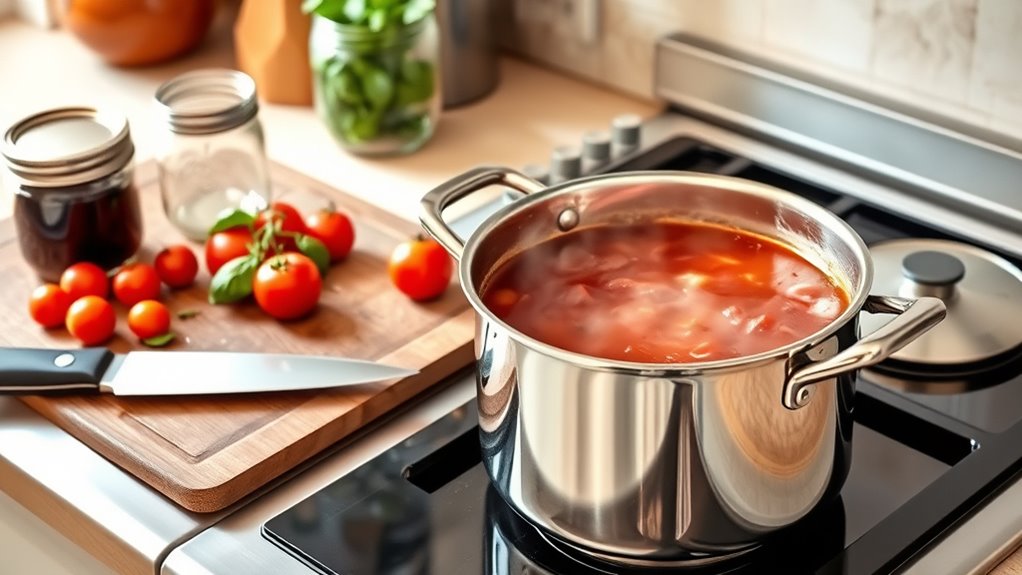
You’ve got your mise en place ready, so now set up the tools that’ll keep the process smooth. In this kitchen, you’ll want reliable canning equipment and essential kitchen essentials that perform under pressure and heat. Gather a stockpot, a wide canning rack, and jars with lids, plus a ladle and a jar funnel for clean transfers. A thermometer helps you nail safe temperatures, and a nonreactive spoon keeps flavors bright. Have tongs, a moisture towel, and a boiling-water canner if you’re processing in batches. For organization, keep a sharp knife and cutting board nearby, plus a timer to track processing times. This setup supports confident, liberated cooking.
| Tool Category | Specific Items |
|---|---|
| Canning Equipment | Boiling-water canner, canning jars, lids, racks |
| Kitchen Essentials | Stockpot, ladle, jar funnel, thermometer, tongs |
How to Cook

- Heat olive oil in a pan.
- Add onions and garlic, cooking until translucent.
- Stir in tomatoes, stock, and a pinch of salt.
- Maintain a steady simmer (avoid boiling) to preserve texture.
- Use a whisk or spoon to break up larger tomato pieces.
- Let the mixture reduce to a cohesive base.
- Add herbs, pepper, and a splash of cream if desired for balance.
- Focus on cooking techniques that maximize flavor without overcooking.
- Purée smoothly for a silkier mouthfeel, or leave rustic for character.
- Taste and adjust acidity and salt as needed.
How to Serve
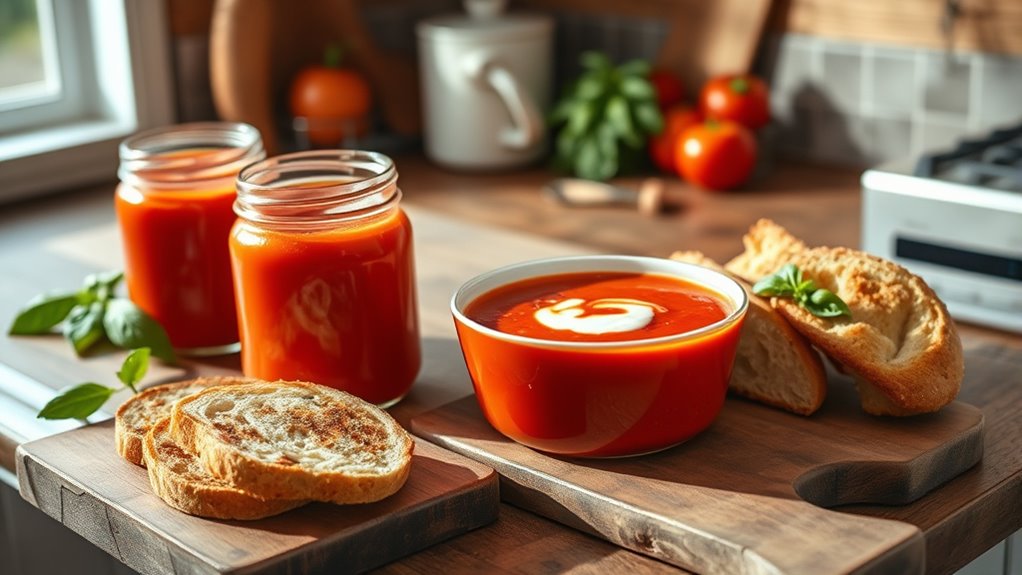
Serve tomato basil soup hot, leaning into its bright aroma and velvety texture. You’ll pour into bowls, then pair it with simple stare-worthy sides. For garnish, consider a swirl of cream, a pinch of chopped basil, or a light dusting of cracked pepper. Garnishing options should enhance aroma without masking flavor, so keep toppings modest and fresh. When you serve, offer a light crusty bread or a grilled cheese finger to dip, turning each bite into comfort and freedom. Regarding serving suggestions, present the soup hot but not steaming, so you can savor the herb brightness. Keep the rhythm honest: generous portions, clear bowls, and a moment to inhale before you taste. Your guests decide the pace; you provide the invitation.
Tips
Here are practical tips to elevate your tomato basil soup: choose ripe tomatoes or a good-quality canned option for depth, and simmer with a splash of olive oil to amplify sweetness. You’ll want a balanced acidity, so taste as you go and adjust with a pinch of sugar if needed. For canning tips, blend the base smooth, then simmer to reduce excess liquid before sealing jars. Add fresh herbs at the end to preserve brightness, avoiding overcooking them. Sterilize jars and bands, and follow your preserving method strictly to guarantee safety. Use headspace guidance and adjust processing times for altitude if applicable. Label batches with date and batch notes for flavor tracking and future adjustments, assuring reliable flavor enhancement every season.
Food Value and Benefit
Tomato basil soup offers excellent nutritional value and multiple health benefits, making it a wholesome addition to your diet. This flavorful dish is rich in essential vitamins and minerals derived from fresh tomatoes and fragrant basil, providing a natural and nourishing option for any meal. Enjoy the vibrant taste along with the following benefits:
- Provides steady energy and enhanced satiety thanks to dietary fiber content
- Rich source of vitamin C and vitamin A, which support immune function and eye health
- Contains potassium and magnesium, important minerals for heart health and muscle function
- Abundant in lycopene from tomatoes, a powerful antioxidant linked to reduced risk of chronic diseases
- Basil contributes additional antioxidants and anti-inflammatory compounds
- Supports balanced nutrition with low calories and minimal processing
- Ideal for preserving during harvest season to maintain freshness and nutrients
- Versatile for use as a main meal, snack, or a flavorful topping on various dishes
Frequently Asked Questions
How Long Can Canned Tomato Basil Soup Be Stored Safely?
You’ll find shelf life around one year if stored in a cool, dark pantry, sealed tightly, and kept stable. You’ll enjoy consistent texture and flavor when storage conditions stay steady, avoiding temperature swings, moisture, and sunlight.
Can I Substitute Fresh Herbs for Dried in Canning?
Yes, you can substitute fresh herbs for dried, but use about three times the fresh amount, and remember flavor intensifies during canning. Pay attention to herb flavor, drying methods, and don’t overcook to preserve vibrant taste.
Do I Need a Pressure Canner for Tomato Soup?
You absolutely don’t need a pressure canner for tomato soup if you’re using proper canning techniques and acidity levels; water bath canning works with tested recipes to guarantee tomato safety, preserving flavor and your culinary freedom.
Is Pasteurized Tomato Sauce Acceptable for Canning?
Yes, pasteurized tomato sauce is acceptable for canning, but you should verify your source and follow safe methods. Pasteurization benefits include extended shelf life, while sauce safety hinges on proper acidity, sterilization, and airtight sealing for reliability.
Can I Freeze Canned Soup After Sealing?
Yes, you can freeze canned soup after sealing, but use proper freezing methods and guarantee tight seals remain intact; for long-term soup storage, chill quickly, portion, and label. Remember, avoid repeated freezing to preserve flavor and texture.
